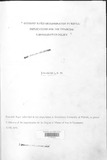| dc.contributor.author | Nyangena, N W | |
| dc.date.accessioned | 2013-05-07T13:05:36Z | |
| dc.date.available | 2013-05-07T13:05:36Z | |
| dc.date.issued | 1991 | |
| dc.identifier.citation | Research Paper submitted to the Department of Economics, University of Nairobi, in partial fulfillment of the requirements for the Degree of Master of Arts in Economics. | en |
| dc.identifier.uri | http://erepository.uonbi.ac.ke:8080/xmlui/handle/123456789/19889 | |
| dc.description.abstract | The study evaluated the relative contribution of domestic and international factors in the determination of the Treasury bill rate in Kenya under a liberalized regime. The evaluation was based on a modified version of the Edwards and Khan (1985) model using. time series data for the period 1969 to 1989.
The empirical findings of the study were that the effects of expected exchange rate, lagged Treasury bill rate and portfolio variables on the level of interest rate in Kenya are statistically significant from zero at five percent level of significance.
The results confirmed that domestic money supply influences interest rates largely through the liquidity effect. An increase in the stock of money, leads to a short-term increase of interest rates .
Further the domestic interest rate responds to monetary changes in international money markets. These had the implication that approximate equilibrium lending and deposit- rates may be achieved easily through careful manipulation of exchange rate and
domestic money supply. | en |
| dc.language.iso | en | en |
| dc.title | Interest rates determination in kenya: implications for the financial liberalization policy | en |
| dc.type | Thesis | en |
| local.publisher | Department of Arts-Economics | en |

